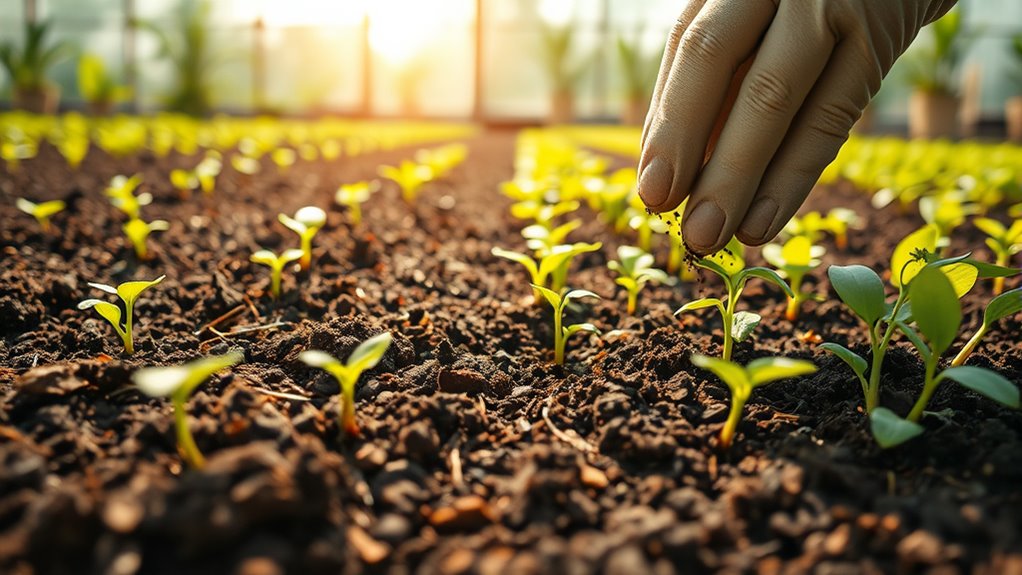To maintain optimal soil health in your greenhouse, focus on boosting beneficial microbes through regular compost additions and avoiding over-application. Keep soil conditions balanced with proper moisture and pH levels, and minimize disturbance by limiting tilling. Incorporate cover crops and rotate plants to prevent pests and enrich the soil naturally. Using mulching and careful management practices will keep your soil vibrant and productive. Continue exploring these strategies to unseal even better results.
Key Takeaways
- Regularly add well-decomposed organic compost to promote beneficial soil microbial activity.
- Monitor and maintain consistent soil moisture and pH levels optimal for microbial health.
- Rotate crops and incorporate cover crops to enhance soil nutrient cycling and microbial diversity.
- Minimize tilling and soil disturbance to preserve microbial networks and soil structure.
- Use mulching and proper drainage to protect soil moisture and prevent erosion, supporting microbial habitats.

Maintaining healthy soil in greenhouses is essential for growing vigorous, high-quality plants. When you focus on soil health, you’re creating an environment that promotes strong root development, better nutrient uptake, and increased resilience against pests and diseases. One of the most critical aspects of soil health is soil microbial activity. These microscopic organisms, including bacteria and fungi, play a crucial role in breaking down organic matter, releasing nutrients, and maintaining the overall balance of your soil ecosystem. When soil microbial activity is robust, your plants benefit from improved nutrient availability, leading to healthier growth and higher yields. To support this activity, you need to manage your compost effectively. Compost management involves regularly adding organic matter to your soil, which serves as food for beneficial microbes. Incorporate well-decomposed compost into your greenhouse soil to enhance microbial populations and ensure a steady supply of nutrients. Avoid over-application, which can lead to nutrient imbalances, and aim for a balanced mix that supports diverse microbial life. Additionally, using soil amendments such as biochar or microbial inoculants can further boost microbial diversity and activity.
Healthy soil with active microbes boosts plant growth and yields in greenhouses.
In addition to compost, it’s important to monitor soil conditions regularly. Keep an eye on moisture levels, as both overly wet and overly dry soil can suppress microbial activity. Maintaining consistent, adequate moisture encourages microbes to thrive and carry out their functions efficiently. Also, consider adjusting your soil pH to suit the plants you’re growing; most vegetables prefer a slightly acidic to neutral pH. When soil conditions are ideal, microbial activity flourishes, and nutrient cycling becomes more efficient, reducing the need for synthetic fertilizers and lowering your input costs.
Crop rotation and cover cropping are also effective strategies to boost soil microbial activity. Rotating crops prevents disease buildup and disrupts pest cycles, while cover crops like clover or vetch add organic matter, protect against erosion, and provide a continuous food source for microbes during off-season periods. These practices keep the soil alive and healthy, fostering a resilient soil ecosystem.
Lastly, avoid disturbing the soil too often. Excessive tilling can break up microbial networks and disturb the delicate balance of your soil environment. Instead, focus on minimal disturbance and mulching to preserve microbial habitats and retain soil moisture. By actively managing compost and fostering soil microbial activity, you set the foundation for a productive greenhouse. Healthy soil is the backbone of successful cultivation, and your careful attention to these elements will pay off with lush, high-quality plants that thrive under your care.
Frequently Asked Questions
How Often Should I Test Soil Ph in My Greenhouse?
You should test your soil pH at least once every 4 to 6 weeks to keep your pH monitoring schedule on track. Regular soil testing frequency helps you catch pH imbalances early, ensuring ideal conditions for plant growth. If you’re growing sensitive plants or adjusting soil amendments, consider testing more often. Consistent pH monitoring allows you to make timely adjustments, maintaining healthy, productive soil in your greenhouse.
What Are Natural Ways to Boost Soil Microbial Activity?
Think of your soil as a busy city. To boost microbial activity naturally, you can spray compost teas, like giving the city a probiotic boost, and plant cover crops, which serve as beneficial residents supporting the ecosystem. These practices enrich soil nutrients, encourage beneficial microbes, and improve soil structure. Incorporate compost teas regularly and rotate cover crops to keep your soil vibrant and thriving, just like a lively, healthy city.
How Can I Prevent Soil Compaction Over Time?
To prevent soil compaction over time, you should focus on soil aeration and organic mulching. Regularly loosen the soil with gentle tilling or aeration tools to improve air flow. Apply organic mulch like straw or compost to protect the soil surface, retain moisture, and reduce pressure from foot traffic or equipment. These practices help maintain healthy soil structure, ensuring roots get enough oxygen and nutrients for ideal plant growth.
What Organic Amendments Improve Soil Fertility Sustainably?
Are you looking for sustainable ways to boost your soil fertility? Organic amendments like compost teas and biofertilizers are excellent choices. Compost teas deliver beneficial microbes directly to your soil, enhancing nutrient cycling. Biofertilizers introduce natural bacteria and fungi that improve nutrient availability. Regular application of these amendments helps maintain healthy, productive soil without synthetic chemicals, ensuring your greenhouse plants thrive naturally and sustainably over time.
How Does Crop Rotation Affect Soil Health in Greenhouses?
You’ll see crop rotation boost soil health by promoting cover cropping and enhancing nutrient cycling. When you rotate crops, you prevent nutrient depletion, reduce pests, and break disease cycles. Cover crops add organic matter and nutrients back into the soil, improving its structure. This practice keeps your greenhouse soil fertile and resilient, supporting healthy plant growth and reducing the need for synthetic inputs, making your system more sustainable.
Conclusion
By paying close attention to your soil health, you set the stage for thriving plants and a successful greenhouse. Regularly amend and test your soil, practice crop rotation, and avoid shortcuts to keep your soil lively and productive. Remember, a healthy soil is the foundation of a fruitful greenhouse. When you nurture your soil, you’re planting the seeds for long-term success—because a chain is only as strong as its weakest link.









